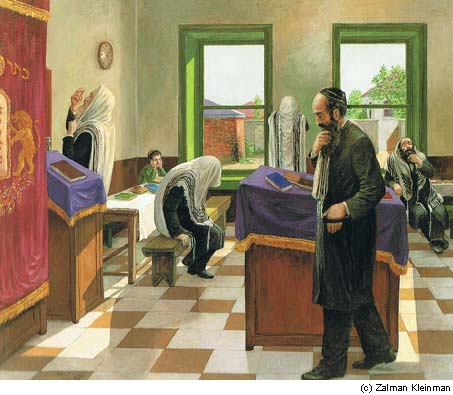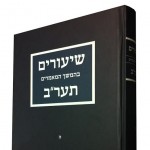By Rabbi Shneur Zalman of Liadi The Alter RebbeTo Understand the Concept of the Tzimtzum 5565-1805 Indented text by the translator
God Speak
In a similar manner we can understand the effect of the breaking of the vessels. God initially revealed ten creation utterances.
The creation utterances are preceded by the words “God said.” The sages taught, “ ‘In the beginning’ is also one of the utterances.” All spiritual and physical entities are continuously created by combinations and permutations of the following Hebrew letters.
-
“In the beginning God created the heavens and the earth”
-
“Let there be light.”
-
“Let there be a firmament in the midst of the waters, and let it separate between water and water.”
-
“Let the waters beneath the heaven be gathered into one area, and let the dry land appear.”
-
“Let the earth sprout vegetation: herbage yielding seed, fruit trees yielding fruit each after its kind, containing its own seed on the earth.”
-
“Let there be luminaries in the firmament of the heaven to separate between the day and the night; and they shall serve as signs, and for festivals and for days and years; and they shall serve as luminaries in the firmament of the heaven to shine upon the earth.”
-
“Let the waters teem with living creatures, and fowl that fly about over the earth across the expanse of the heavens.”
-
“Let the earth bring forth living creatures, each according to its kind: animal, and creeping thing, and beast of the land, each according to its kind.”
-
“Let us make Man in our image after Our likeness. Man shall rule over the fish of the sea, the birds of the sky, and over the animals, the whole earth, and every creeping thing that creeps upon the earth.”
-
“It is not good for man to be alone; I will make him a helper corresponding to him.”
The vessels then shattered, and the letters contained in the above verses separated from each other. Remnants of the broken vessels—orphaned letters—fell below. There they brought the three lower worlds into existence. The diminutive life force enclosed within each letter created the “soul of the world of Creation.”
Even the souls of Moses and King David were created from these shattered vessels. Their souls, however, descended from the inner aspect of the broken vessels; whereas angels are derived from the external aspect.
Cherubic Chastisement
From the above discussion we can discern a further distinction between the world of Emanation and the three lower worlds. The lower worlds manifest a separation from God. Consequently, free choice, reward and punishment are operative there. Angels can sin, and when they fail to serve God properly they are punished. The sages recounted such an episode: “Mattatron—chief of the angels—was led out and flogged with 60 whacks of light. They asked him, ‘Why didn’t you stand?’ ”
Angel Apostatized
“Mattatron,” the Talmud relates, “had been given permission to sit down and inscribe the merits of the Jews.” When a sage appeared he should have stood up. Seeing an angel sitting in the supernal world violated the Torah tradition that “there is no rest or sitting above.”
The sage deduced that Mattatron’s deed verified the existence of two separate domains: God’s and nature’s. He thereupon became an apostate. The sixteenth-century commentator, the Maharsha, points out: “Mattatron was punished for failing to stand. His being seated misled the sage, who didn’t know permission had been granted.”
Job describes the fallibility of angels: “Behold, He cannot have faith even in His holy beings, and the Host of Heaven are not pure in His eyes.” And, “He cannot have faith even in His servants and finds fault with His angels.” Angels can transgress, since they were created from shattered vessels.
Spotless Souls
This is not the case in the world of Emanation; its vessels are complete. And they are completely nullified to Emanation’s lights, as the Zohar writes, “He and His vessels are one.” That’s why David says of Emanation, “no evil sojourns with you.” Free choice doesn’t apply in the world of Emanation, since there the lights and vessels are unified. What’s more, a human being whose soul (neshamah) originates from Emanation can never transgress. Should a temptation present itself to which he’d inevitably succumb, he dies before doing so. His soul then returns to Emanation. For regarding Emanation “no evil sojourns with you.” This is not the case in Creation, Formation, and Action. The Torah discusses, for example, the failure of King David.
Stunned Scripture
Therefore Scripture wonders, “If a soul (nefesh) will sin; if he accepted a demand for an oath, and he is a witness?” The Torah doesn’t say “If a neshamah will sin” because it can’t.
Divine souls possess five levels: yehidah, hia, neshamah, ruach, and nefesh. The bottommost, nefesh, corresponds to the world of Action. As such, it is distinguished from neshamah, which can derive from Emanation.
“Nonetheless,” the Zohar comments, “even regarding the lowly nefesh, Scripture is incredulous. Since ‘He is a witness a nefesh will sin?’ Prior to its descent, a nefesh was bound up in its source, where it witnessed God’s glory. How then can a nefesh sin, even when it is down on earth?”
Non-Emanation-based souls are capable of transgression due to their shattered-vessel source. Still, Scripture wonders how they can sin.
Divine Devices
Different types of vessels are present in the higher worlds. Some receive effluence, while others measure it out in set amounts. For example, we measure quantities of wine and oil in what the sages called measuring vessels in quantities called hins and lugs. Correspondingly, above, the vessel of the sefira of Wisdom measures Wisdom’s light into defined quantities. The extent of Wisdom’s light is set by its vessel.
A second category of vessels are termed “measuring ropes or rods.” Their function is similar to a builder’s tape measure. So too above, divine effluence is measured by a vessel called a measuring line or rod. Workers used such a device to measure the length and width of the Tabernacle’s curtains and coverings.
A third class of divine vessels doesn’t receive effluence. Rather, they function as mere conduits, transporting effluence below. Through them, divine light flows from the bestower to the recipient.
Knives demonstrate the property of such vessels. Knives are flat metal objects, incapable of receiving substances within them. How do knives illustrate the principle of transference?
Suppose someone wishes to cut an object in half. By means of the sharp instrument, a person transfers his effluence to the now-sliced object. The knife is the device by which his influence affects the object. In a similar manner, divine conduits only transfer effluence from a bestower to a recipient.
References
God Speak
ten creation utterances
Mishnah, Tractate Avot, chapter 5, law 1;
Pesikta Rabbatei chapter 21, section 19;
The Second Book of the Zohar, page 14, side b;
The creation utterances are preceded by the words “God said.”
Pirkei d’Rabbi Eliezer, chapter 3;
Torah Temimah, Genesis, chapter 1, verse 1.
“ ‘In the beginning’ is also one of the utterances.”
The First Book of the Zohar, page 30, side a;
The Zohar, Hashmatot, page 246, side b;
The Babylonian Talmud, Tractate Rosh Hashana, page 32, side a; ibid., Tractate Megilla, page 32, side a.
All spiritual and physical entities are continuously created by combinations
Raya Mehemna, The Second Book of the Zohar, page 257, side b;
Pardess Rimmonim, portal 6, chapter 8;
Eitz Chaim, portal 23, chapter 5;
“In the beginning God created the heavens and the earth.”
The Book of Genesis, chapter 1, verse 1.
“Let there be light.”
Ibid., chapter 1, verse 3.
“Let there be a firmament in the midst of the waters and let it separate …”
Ibid., chapter 1, verse 6.
“Let the waters beneath the heaven be gathered into one area, and let …”
Ibid., chapter 1, verse 9.
“Let the earth sprout vegetation: herbage yielding seed, fruit trees …”
Ibid., chapter 1, verse 11.
“Let there be luminaries in the firmament of the heaven to separate …”
Ibid., chapter 1, verse 14.
“Let the waters teem with living creatures, and fowl that fly about …”
Ibid., chapter 1, verse 20.
“Let the earth bring forth living creatures, each according to its …”
Ibid., chapter 1, verse 24.
“Let us make Man in our image after Our likeness. Man shall rule over …”
Ibid., chapter 1, verse 26.
“It is not good for man to be alone; I will make him a helper …”
Ibid., chapter 2, verse 18.
Their souls, however, descended from the inner aspect of the broken vessels
Pardess Rimmonim, portal 31, chapter 1;
Eitz Chaim, portal 28, chapter 1;
Pri Eitz Chaim, portal 18, chapter 5.
angels are derived from the external aspect
Eitz Chaim, portal 40, chapter 10; ibid., portal 50, chapter 6;
Pri Eitz Chaim, portal 18, chapter 5.
Cherubic Chastisement
Mattatron—chief of the angels
The First Book of the Zohar, page 95, side b;
Tosfos on The Babylonian Talmud, Tractate Yevomot, page 15, side b;
“Mattatron—chief of the angels—was led out and flogged with 60 …”
The Babylonian Talmud, Tractate Chagigah, page 15, side a.
Angel Apostatized
“Mattatron was punished for failing to stand. His being seated misled …”
Maharsha on The Babylonian Talmud, Tractate Chagigah, page 15, side a.
“Behold, He cannot have faith even in His holy beings, and the Host …”
The Book of Job, chapter 15, verse 15.
“He cannot have faith even in His servants and finds fault with His angels.”
Ibid., chapter 4, verse 18.
Spotless Souls
That’s why David says of Emanation: “no evil sojourns with you.”
Pardess Rimmonim, portal 20, chapter 1.
“no evil sojourns with you”
The Book of Psalms, chapter 5, verse 5.
Stunned Scripture
“If a soul (nefesh) will sin; if he accepted a demand for an oath, and he …”
The Book of Leviticus, chapter 5, verse 1.
Divine souls possess five levels: yehidah, hia, neshamah, ruach, and nefesh.
Devorim Rabbah, chapter 2, section 37;
Eitz Chaim, portal 42, chapter 1.
The bottommost, nefesh, corresponds to the world of Action.
Sha’ar HaGilgulim, chapter 1.
neshamah, which can derive from Emanation
Eitz Chaim, portal 15, chapter 2; ibid., portal 50, chapter 10;
Remez on The Second Book of the Zohar, page 290, side b.
“Nonetheless,” the Zohar comments, “even regarding the lowly nefesh …”
The Third Book of the Zohar, page 13, side b.
Non-Emanation-based souls
Remez on The Second Book of the Zohar, page 290, side b.
Prior to its descent, a nefesh was bound up in its source
The Book of Deuteronomy, chapter 4, verse 4;
The First Book of the Zohar, page 163, side b.
Divine Devices
“measuring vessels” in quantities called hins and lugs
The Book of Leviticus, chapter 19, verse 36;
Mishnah, Tractate Menachot, chapter 9, law 2;
Maimonides, Mishnah Torah, Hilchot Genaivah, chapter 7, law 7.
“measuring ropes or rods”
Rashi on The Babylonian Talmud, Tractate Baba Basra, page 107, side b.
Rather, they function as mere conduits, transporting effluence below
Eitz Chaim, portal 34, chapter 2.







